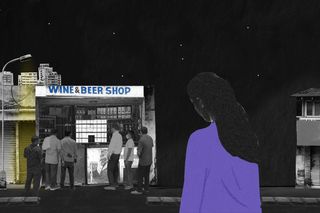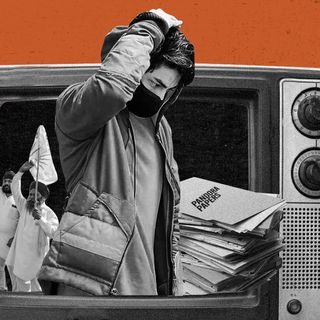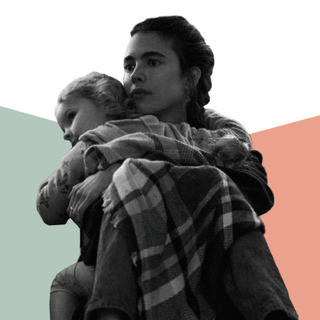
How Cities Are Designed to Restrict Women’s Access to Drinking Culture
“When infrastructure doesn’t take into account women’s needs, it automatically excludes them.”

For P., the desire to drink a vodka tonic involves an obstacle course. The Good Old Wine Shop is the end destination, located some six kilometers from the central city, where she lives. She avoids going to the Crowded Old Wine Shop; the long queues and derisive looks are morality taxes she doesn’t feel like paying.
The 27-year-old has “never felt safe drinking alone at a bar,” hence the physical and emotional gymnastics. She hails another auto on her way back, sure to hide the bottle. “These better shops are mostly targeted to IT hubs or more developed areas. I still prefer to travel and shop there — it feels more comfortable.” “Better” here is shorthand for a lot of things, safety chief among those.
There are two aspects women navigate to engage with the drinking culture. Patriarchal norms that frown upon a relationship between women and alcohol; and cities that weren’t designed to accommodate women’s experiences. How one influences the other makes drinking “an adventure sport” for women, as Shruti Patil, a researcher of gender equality and urban cities, says.
Who occupies which spaces?
“When infrastructure doesn’t take into account women’s needs, it automatically excludes them,” Patil explains. The liquor shop sits in well-deserved infamy. As a male-dominated space, thekas or local liquor shops erect cultural barriers at once. These shops are usually located in “shady” areas, as P. and others describe them, with few street lights and broken pavements.
Another aspect of urban design is one of segregating neighborhoods. New urban developments have focused on forming single-use neighborhoods demarcated for recreational purposes, like the Hauz Khas Village or residential sites. This is where urban leisure places find traditionally cheaper rent rates and more accessible space to expand into bigger establishments.
However, this approach is somewhat as well be gender-blind areas that combine residential, work, commercial, and recreational uses are “not just more convenient, vibrant, connected, and affordable, they’re also safer,” Saanchi Saxena, a gender and city anthropologist, argues. As the urban activist Jane Jacobs puts it, these neighborhoods become self-contained “eyes on the street.”
Related on The Swaddle:
Why Were There Almost No Women in India’s Liquor Store Queues?
The other alternative for women is large shops where alcohol is sold privately, a preferred option for people who have the privilege, access, and liberty to drink. “Booze malls” (daaru malls) are popular among middle-class and elite consumers who live around these areas. The liquor sold here is, as a result, more expensive too. “There are also patriarchal norms and ‘morality’ that is attached to the very act of drinking which percolates class and caste more than gender,” says gender and city researcher Nirupama Jayaraman.
Some states recently opened women-only alcohol shops to construct a semblance of safety. Newer initiatives like home delivery of alcohol are a way for women to access a skewed drinking culture easily. “I always prefer home delivery to going to the shop,” S. says. She explains that it’s logistically and ideologically uncomfortable to access these spaces.
The growing privatization of drinking culture (through private liquor shops or women-only stores) does provide a sense of safety and anonymity to women. But, it still falls “under patriarchal notions of what a woman’s relationship to alcohol should be,” Saxena concedes.
Where do women drink?
In 2019, a survey found that women were drinking as much as men. This, coupled with the idea that the women’s alcohol market is expected to grow by 25%, painted an optimistic picture for corporations. The story of how and where people consume alcohol, however, forms a critical albeit ignored subtext. A study spanning seven states found a growing base of Indian women who chose to drink at home.
Most of those who drink outside start and end at the chosen bar or restaurant for the night. According to this thinking, a city’s approach to alcohol will focus only on regulations — around alcohol sale, drinking age, or other consumption policies — within the establishment. And not the broader considerations involving the location of the restaurant itself.
But by its virtue, the drinking culture is gendered. For women, alcohol consumption carries a weighted link to vulnerability and increased responsibility for safety.
Deciding where to go drinking is a minor technicality in this adventure sport; other considerations include the neighborhood, the nearest parking, conveyance, how crowded the area is. Other anecdotes — of women going in pairs to the washroom or always having a male drinker in their group — show the many considerations, often intuitive, that go into making decisions about drinking in public.
“Women are looking for different markers. Does the place have a good track record of standing up for women or seeking help in case of an emergency? Gosh, is the lighting obnoxious,” Patil highlights. “We end up paying more for fewer drinks.” Patil calls this the “pink tax.”
In a paper this year, researchers looked at hubs like the Hauz Khas Village in New Delhi that are known for boutique bars offering “ladies’ nights. “Two free Vodka shots for you, sir, if you have female friends in your group, two extra shots for them!!” reads a flier.
Despite these promotional campaigns, the public space doesn’t transform into an inclusive site where women could access leisure. While these bars are positioned as safe and inclusive, the responsibility of the premise “ended where their doors ended.”
“The distance from the premise entrance to the taxi bay and parking area was not accounted for by the bars where women were the most vulnerable to drunken men’s unwanted attention in a poorly lit street,” the researchers noted.
Any argument for an inclusive drinking culture must make peace with the following idea: women use and navigate the city differently. Women in cities tend to walk more than men; this makes amenities like well-lit streets and maintained footpaths a necessity. According to an audit by SafetiPin, Delhi’s markets and commercial areas had at least 1,500 blind spots — areas that didn’t have proper street lighting.
Research also shows that women are more dependent on public transports, making low-cost and accessible transportation critical for women’s mobility. Saanchi Saxena notes it is the availability of cabs or an auto that determines the place she picks.
Related on The Swaddle:
Why don’t women fit in?
Women’s safety aside, in India, women are not seen as the drinking class, to begin with. The rebel class who do drink — and publically at that — are looked upon with unmistakable derision.
In 2007, writer George Saunders made an interesting case about conceptual architecture. He argued the sophisticated language we hear and use to describe our world determines the sophistication of our thinking. This thinking applies when we engage with social norms or mull over urban design.
What language, then, do we use to describe women and drinking?
A 2019 research showed women who drink alcohol are judged more harshly (in that they are “less human” and “more sexually available”) than men. The prejudice forms invisible lines that objectify women and make them feel out of place, a barrier that spills into the city’s design. In this case, this relationship is chalked as that should be confined to their homes, not in the city.
This opens a private vs. public binary. In the form of malls, expensive bars, and gentrification, the rise of drinking spaces has overlapped with a worrying scarcity of free and accessible public spaces. Patriarchal norms, Saxena argues, are linked to the growing privatization of urban leisure. It reflects “the modernist, patriarchal understanding of the private as the women’s domain, and the public as the man’s domain,” as Saxena puts it. In other words, if women aren’t meant to be in the public domain, the urban city — its design and drinking experience — isn’t obligated to respond to gender-sensitive needs.
At its heart, the battle to access public drinking spaces is one of fighting for leisure. Urban infrastructure, in the form of street planning or access to transport, does not accommodate women’s spaces of leisure or loitering. Women need to demonstrate a “respectable” purpose for being out in a public space, and drinking is not one of them.
At one level, this relieves the city of its obligation to design spaces inclusive of people who aren’t “supposed” to be there. It clings to a narrow idea of drinking culture, which overlooks tangents like parking or the different ways women access cities. Going back to Saunders’s argument, the dismissive language around women’s leisure also seeps into the biases around city planning.
At the same time, a gender-blind city infrastructure also reaffirms prejudices about who gets to drink. “Where your mobility is already restricted, drinking must always be a transgression,” Patil notes.
***
“Urban spaces reflect and reinforce social hierarchies,” says Saxena. It’s a vicious cycle. An unsafe city makes it difficult for women to loiter or carry out leisure activities. This translates into a lesser number of women visible in public spaces, further making a city unsafe. Any feminist consideration for the construction of a public space that encourages drinking must extend beyond mere safety. Conversely, professions such as architecture, construction, and land economics have a lower proportion of women also shape the discourse around an inclusive drinking culture.
The freedom to take up the risk of being free can only happen if a city is receptive to women. This involves adequate street lighting, public toilets, extensive public transport, affordable housing near workplaces, and walkable streets. This is “not just to improve end to end connectivity but also to bolster women’s independence,” Patil notes. Policymakers must incorporate gender-sensitive infrastructure planning and inclusive design.
A geographical reading of the drinking culture can then help interrogate social biases and boost efforts to make cities safer. A societal change, Saxena argues, is needed to recognize women’s claim as equal urban citizens. Who are “free to enjoy not just the freedoms that come with it, but also the risks that accompany it.”
The city is a maze — of experiences, norms, ideas. The length and breadth of this obstacle course could do with some enlightenment.
Saumya Kalia is an Associate Editor at The Swaddle. Her journalism and writing explore issues of social justice, digital sub-cultures, media ecosystem, literature, and memory as they cut across socio-cultural periods. You can reach her at @Saumya_Kalia.
Related


Why There’s More Distraction, Less News in the Media
